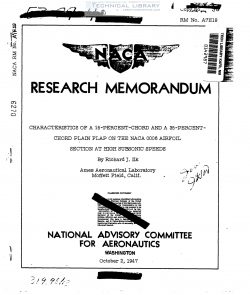naca-rm-a7h19
- Version
- 200 Downloads
- 1.02 MB File Size
- 1 File Count
- March 14, 2017 Create Date
- March 14, 2017 Last Updated
National Advisory Committee for Aeronautics, Research Memorandum - Characteristics of a 15% Chord and a 35% Chord Plain Flap on the NACA 0006 Airfoil Section at High Subsonic Speeds

Wind—tunnel tests have been made to determine the aerodynamic
characteristics of a 15-percent— and a 35—percent-chord plain
trailing-edge flap on the NACA 0006 airfoil section. Simultaneous,
measurements of section lift, drag, and pitching moment were made ,
over a range of Mach numbers from 0.3 to approximately 0.9 at angles
of attack ranging from —8° to 12° for flap deflections of 0°, 5°, and
10°. Increments of section lift coefficient and changes in airfoil
angle of attack necessary to maintain constant lift with unit changes
in flap deflection are presented as a measure of the effectiveness at
high'subsonic speeds of a. plain flap employed on a. very thin profile.
An analysis of the test results shows that, for small flap
deflections, the increment of lift coefficient produced by a plain
flap on the NACA 0006 airfoil at 0.875 Mach number is substantially
the same as or greater than that realized. at low speeds. A study
of the relative effectiveness of two flap sizes indicates that, on thin
airfoils, the loss in flap effectiveness at high subsonic speeds is
considerably less for a large-chord than for a shall-chord flap.
The effectiveness of the flaps of the present investigation
has been compared with that of a. 20—percent-ch0rd plain flap on
both a modified NACA 65,3-019 and the NACA 65—210 airfoils. From
this comparison it appears that, at high subsonic speeds, the
rate of decrease in effectiveness of a plain flap on these three
airfoils is the least severe for the airfoil with the smallest
chord ratio.
Various high—speed investigations of lift-control devices have
indicated that a. pronounced decrease in the effectiveness of such
devices occurs at high subsonic speeds. A comparison is made in
reference 1 of the effectiveness of three types of lift controls:
a. plain trailing—edge flap, a dive—recovery flap, and a spoiler.
Although the experimental results presented for these controls show
that each remains effective at Mach numbers between those for airfoil
lift divergence and 0.875, it appears that the plain trailing—edge
flap exhibits the least variation in lift—control effectiveness for
Mach numbers from 0.3 to 0.875. The data of reference 1 also
indicate that a reduction in airfoil thickness-chord ratio delays the
onset of the abrupt loss in the plain—flap effectiveness to higher
Mach numbers.
The present investigation was undertaken to provide information
on the respective characteristics of relatively small—chord and large—
chord flaps on a very thin profile at high subsonic speeds. Values
of control effectiveness for two sizes of plain flap are obtained
from lift-coefficient data. These values are compared to show the
influence ofa variation in flap-chord ratio on the flap effective—
ness at high speeds
| File | Action |
|---|---|
| naca-rm-a7h19 Characteristics of a 15% Chord and a 35% Chord Plain Flap on the NACA 0006 Airfoil Section at High Subsonic Speeds.pdf | Download |

Comment On This Post